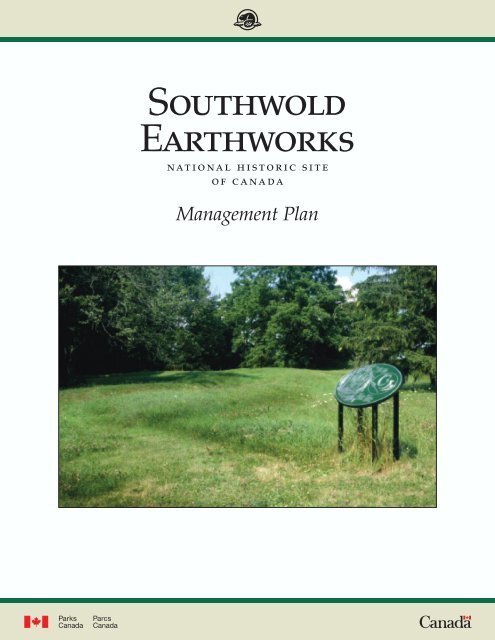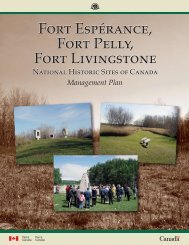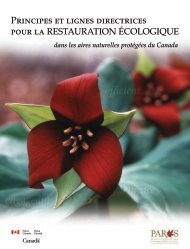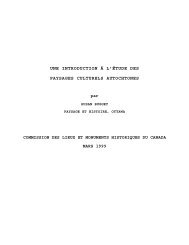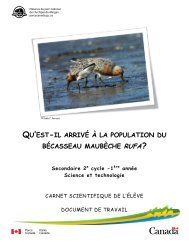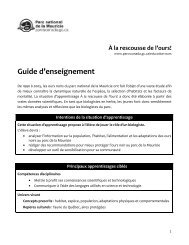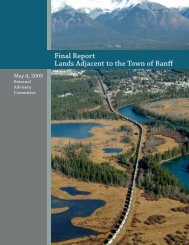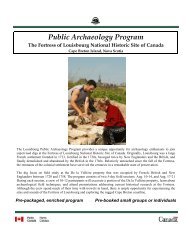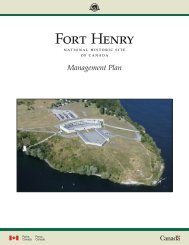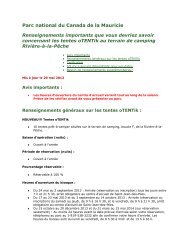Southwold Earthworks National Historic Site of Canada ...
Southwold Earthworks National Historic Site of Canada ...
Southwold Earthworks National Historic Site of Canada ...
You also want an ePaper? Increase the reach of your titles
YUMPU automatically turns print PDFs into web optimized ePapers that Google loves.
© Copyright Her Majesty the Queen in Right <strong>of</strong> <strong>Canada</strong>, as represented by<br />
the Chief Executive Officer <strong>of</strong> Parks <strong>Canada</strong>, 2007<br />
Government <strong>of</strong> <strong>Canada</strong> Catalogue No. R64-105/44-2006E<br />
ISBN: 0-662-44233-4<br />
Aussi disponible en français
<strong>Southwold</strong><br />
<strong>Earthworks</strong><br />
national historic site<br />
<strong>of</strong> canada<br />
Management Plan<br />
February, 2007
SOUTHWOLD EARTHWORKS NATIONAL HISTORIC SITE OF CANADA<br />
Management Plan<br />
TABLE OF CONTENTS<br />
1.0 INTRODUCTION . . . . . . . . . . . . . . . . . . . . . . . . . . . . . . . . . . . . . . . . . . . . . . . . . . . . . . . . .1<br />
1.1 PURPOSE OF THE MANAGEMENT PLAN . . . . . . . . . . . . . . . . . . . . . . . . . . . . . . . .1<br />
1.2 LOCAL AND REGIONAL CONTEXT . . . . . . . . . . . . . . . . . . . . . . . . . . . . . . . . . . . . .1<br />
2.0 IMPORTANCE OF SOUTHWOLD EARTHWORKS TO THE<br />
NATIONAL HISTORIC SITES SYSTEM . . . . . . . . . . . . . . . . . . . . . . . . . . . . . . . . . . . .2<br />
3.0 COMMEMORATIVE INTENT AND DESIGNATED PLACE . . . . . . . . . . . . . . . . . . .2<br />
3.1 CONCEPT OF COMMEMORATIVE INTEGRITY . . . . . . . . . . . . . . . . . . . . . . . . . . .2<br />
3.2 REASONS FOR DESIGNATION OF SOUTHWOLD EARTHWORKS . . . . . . . . . .2<br />
3.3 STATEMENT OF COMMEMORATIVE INTENT AND DESIGNATED PLACE . .2<br />
4.0 CURRENT SITUATION . . . . . . . . . . . . . . . . . . . . . . . . . . . . . . . . . . . . . . . . . . . . . . . . . . . .3<br />
4.1 RESOURCES DIRECTLY RELATED TO THE REASONS<br />
FOR NATIONAL SIGNIFICANCE . . . . . . . . . . . . . . . . . . . . . . . . . . . . . . . . . . . . . . . . . . .3<br />
4.2 MESSAGES OF NATIONAL SIGNIFICANCE . . . . . . . . . . . . . . . . . . . . . . . . . . . . . .3<br />
4.3 VISITOR USE AND OPERATIONS . . . . . . . . . . . . . . . . . . . . . . . . . . . . . . . . . . . . . . . .4<br />
4.4 FIRST NATIONS INVOLVEMENT . . . . . . . . . . . . . . . . . . . . . . . . . . . . . . . . . . . . . . . .4<br />
5.0 VISION . . . . . . . . . . . . . . . . . . . . . . . . . . . . . . . . . . . . . . . . . . . . . . . . . . . . . . . . . . . . . . . . . .5<br />
6.0 MANAGEMENT OBJECTIVES AND ACTIONS . . . . . . . . . . . . . . . . . . . . . . . . . . . . . .5<br />
6.1 MANAGEMENT OBJECTIVES . . . . . . . . . . . . . . . . . . . . . . . . . . . . . . . . . . . . . . . . . . .5<br />
6.2 MANAGEMENT ACTIONS . . . . . . . . . . . . . . . . . . . . . . . . . . . . . . . . . . . . . . . . . . . . . .5<br />
7.0 FIRST NATIONS INVOLVEMENT . . . . . . . . . . . . . . . . . . . . . . . . . . . . . . . . . . . . . . . . .6<br />
8.0 PARTNERSHIPS AND PUBLIC INVOLVEMENT . . . . . . . . . . . . . . . . . . . . . . . . . . . .7<br />
9.0 IMPLEMENTATION . . . . . . . . . . . . . . . . . . . . . . . . . . . . . . . . . . . . . . . . . . . . . . . . . . . . . .7<br />
10.0 ENVIRONMENTAL ASSESSMENT . . . . . . . . . . . . . . . . . . . . . . . . . . . . . . . . . . . . . . . . .7<br />
APPENDICES<br />
FIGURE 1 - REGIONAL CONTEXT . . . . . . . . . . . . . . . . . . . . . . . . . . . . . . . . . . . . . . . . . . .9<br />
FIGURE 2 - LOCAL CONTEXT . . . . . . . . . . . . . . . . . . . . . . . . . . . . . . . . . . . . . . . . . . . . .10<br />
FIGURE 3 - PRESENT CONDITIONS . . . . . . . . . . . . . . . . . . . . . . . . . . . . . . . . . . . . . . . .11<br />
FIGURE 4 - PLAN OF THE VILLAGE INFERRED FROM<br />
THE 1976 EXCAVATIONS . . . . . . . . . . . . . . . . . . . . . . . . . . . . . . . . . . . . . .12<br />
page iii
SOUTHWOLD EARTHWORKS NATIONAL HISTORIC SITE OF CANADA<br />
Management Plan<br />
1.0 INTRODUCTION<br />
This is a management plan for <strong>Southwold</strong> <strong>Earthworks</strong><br />
<strong>National</strong> <strong>Historic</strong> <strong>Site</strong> <strong>of</strong> <strong>Canada</strong>, which is located in<br />
southwestern Ontario in rural <strong>Southwold</strong> Township.<br />
The site is a rare example <strong>of</strong> an Aboriginal village<br />
surrounded by a double ring <strong>of</strong> earthworks, built by<br />
the Neutral Iroquois about A.D. 1450 to 1550.<br />
1.1 PURPOSE OF THE MANAGEMENT PLAN<br />
A management plan is a strategic document that<br />
guides management <strong>of</strong> a national historic site. It has a<br />
10-15 year lifespan, and is reviewed every 5 years and<br />
adjusted to reflect new conditions, policy direction<br />
and legislation. It is required by the Parks <strong>Canada</strong><br />
Agency Act, guided by public consultation and<br />
approved by the Minister <strong>of</strong> the Environment. In<br />
addition to the Parks <strong>Canada</strong> Agency Act, preparation<br />
<strong>of</strong> this management plan is guided by the <strong>Historic</strong> <strong>Site</strong>s<br />
and Monuments Act and Parks <strong>Canada</strong>’s Guiding<br />
Principles and Operational Policies, including the<br />
Cultural Resource Management Policy.<br />
1.2 LOCAL AND REGIONAL CONTEXT<br />
<strong>Southwold</strong> <strong>Earthworks</strong> is a pre-contact site <strong>of</strong> the<br />
Neutral Iroquois people, established sometime<br />
between A.D. 1450 and 1550. The <strong>Southwold</strong> village<br />
occupies an area <strong>of</strong> about 0.8 ha (2 acres) surrounded<br />
by a double ring <strong>of</strong> earthworks. The site is in<br />
southwestern Ontario in rural <strong>Southwold</strong> Township,<br />
Elgin County, on the banks <strong>of</strong> a tributary <strong>of</strong> Talbot<br />
Creek approximately 20 km west <strong>of</strong> St. Thomas,<br />
Ontario. It is a non-operational site with minimal<br />
facilities.<br />
The property is in a park-like setting, surrounded by a<br />
hardwood forest to the north and and cultivated<br />
agricultural lands to the east, west and south.<br />
Scattered trees, predominantly mature hardwoods, are<br />
now found within the earthworks. Grasses and<br />
wildflowers cover the ground.<br />
<strong>National</strong> historic sites exist under the authority <strong>of</strong> the<br />
<strong>Historic</strong> <strong>Site</strong>s and Monuments Act. Through the Act, the<br />
Government <strong>of</strong> <strong>Canada</strong> gives <strong>of</strong>ficial recognition <strong>of</strong><br />
historic places through the approval by the Minister <strong>of</strong><br />
the Environment, upon recommendations made by<br />
the <strong>Historic</strong> <strong>Site</strong>s and Monuments Board <strong>of</strong> <strong>Canada</strong>.<br />
The management plan for <strong>Southwold</strong> <strong>Earthworks</strong><br />
<strong>National</strong> <strong>Historic</strong> <strong>Site</strong> <strong>of</strong> <strong>Canada</strong> (NHSC) will help<br />
guide decision-making towards achieving<br />
commemorative integrity and providing opportunities<br />
for visitor use and enjoyment <strong>of</strong> the site<br />
This is the second management plan for <strong>Southwold</strong><br />
<strong>Earthworks</strong>. The first plan, completed in 1982,<br />
outlined a modest degree <strong>of</strong> site development which<br />
has been implemented. Parks <strong>Canada</strong> is just beginning<br />
to involve First Nations in discussions about<br />
management <strong>of</strong> the site, which will be reflected the<br />
next time the plan is reviewed, in five years.<br />
page 1
SOUTHWOLD EARTHWORKS NATIONAL HISTORIC SITE OF CANADA<br />
Management Plan<br />
2.0 IMPORTANCE OF<br />
SOUTHWOLD EARTHWORKS TO<br />
THE NATIONAL HISTORIC SITE<br />
SYSTEM<br />
<strong>Southwold</strong> <strong>Earthworks</strong> is part <strong>of</strong> a nation-wide family<br />
<strong>of</strong> over 900 sites. Each site has had a nationally<br />
significant impact on Canadian history or illustrates a<br />
nationally important aspect <strong>of</strong> the history <strong>of</strong> <strong>Canada</strong>.<br />
They commemorate thousands <strong>of</strong> years <strong>of</strong> human<br />
history and a rich variety <strong>of</strong> themes, spanning<br />
political, economic, intellectual, cultural and social<br />
life.<br />
The <strong>National</strong> <strong>Historic</strong> <strong>Site</strong>s Systems Plan has<br />
organized Canadian history into themes. Within this<br />
plan, <strong>Southwold</strong> <strong>Earthworks</strong> represents the sub-theme<br />
‘<strong>Canada</strong>’s Earliest Inhabitants’ under the theme<br />
‘Peopling the Land’. It is also one <strong>of</strong> 154 <strong>National</strong><br />
<strong>Historic</strong> <strong>Site</strong>s administered by Parks <strong>Canada</strong> and<br />
which, together with our <strong>National</strong> Parks and <strong>National</strong><br />
Marine Conservation Areas comprise our unique<br />
heritage places, places which foster a sense <strong>of</strong> national<br />
identity and pride as well as appreciation for this rich<br />
and diverse county we share.<br />
3.0 COMMEMORATIVE<br />
INTEGRITY<br />
3.1 CONCEPT OF COMMEMORATIVE<br />
INTEGRITY<br />
Parks <strong>Canada</strong>’s primary responsibility at <strong>Southwold</strong><br />
<strong>Earthworks</strong> is to ensure its commemorative integrity.<br />
This term refers to the health and wholeness <strong>of</strong> a<br />
historic site. A site is said to possess commemorative<br />
integrity when the resources that symbolize or<br />
represent its importance are not impaired or under<br />
threat; the reasons for the site’s national historic<br />
significance are effectively communicated to the<br />
public; and the site’s heritage values are respected by<br />
all whose decisions or actions affect the site.<br />
Commemorative Integrity Statements are prepared for<br />
each site owned by Parks <strong>Canada</strong>. These documents<br />
identify what was commemorated and why; which<br />
resources are nationally significant, their value and<br />
objectives for their protection; the messages <strong>of</strong><br />
national significance and objectives for their effective<br />
communication; and other heritage values, resources<br />
and messages associated with the site. They are key<br />
documents used in the preparation <strong>of</strong> management<br />
plans.<br />
3.2 REASONS FOR DESIGNATION OF<br />
SOUTHWOLD EARTHWORKS<br />
<strong>Southwold</strong> <strong>Earthworks</strong> was one <strong>of</strong> the very first sites<br />
considered by the <strong>Historic</strong> <strong>Site</strong>s and Monuments<br />
Board <strong>of</strong> <strong>Canada</strong>. Indeed, the site was one <strong>of</strong> the first<br />
topics discussed at the initial meeting <strong>of</strong> the Board in<br />
1919. On the Board’s recommendation, the site was<br />
declared to be <strong>of</strong> national significance in 1923, and it<br />
was purchased by the federal government in 1929.<br />
The 1983 plaque text states: “This prehistoric site was<br />
once a fortified village occupied by the Neutral<br />
Indians between about 1500 and 1650 AD. An earth<br />
and palisade wall, later strengthened by a second<br />
wall, protected a cluster <strong>of</strong> longhouses. The Neutrals,<br />
who emerged as a distinct group within Iroquois<br />
culture about 1450, were so-called because they did<br />
not participate in wars with traditional Iroquois rivals.<br />
This neutrality aroused the ire <strong>of</strong> the Iroquois<br />
Confederacy, and Mohawk and Seneca raids brought<br />
about the demise <strong>of</strong> the Neutral nation by 1650.”<br />
3.3 STATEMENT OF COMMEMORATIVE INTENT<br />
AND DESIGNATED PLACE<br />
A Statement <strong>of</strong> Commemorative Intent is part <strong>of</strong> the<br />
Commemorative Integrity Statement. It refers to the<br />
reasons for a site’s designation as a national historic<br />
site. A statement <strong>of</strong> commemorative intent provides<br />
the answer to the question “When and for what reason<br />
was this site designated by the Minister responsible<br />
for the <strong>Historic</strong> <strong>Site</strong>s and Monuments Act as a national<br />
page 2
SOUTHWOLD EARTHWORKS NATIONAL HISTORIC SITE OF CANADA<br />
Management Plan<br />
historic site?” The designated place refers to the exact<br />
property that was commemorated.<br />
In March 2005, the <strong>Historic</strong> <strong>Site</strong>s and Monuments<br />
Board <strong>of</strong> <strong>Canada</strong> discussed the site and provided the<br />
following information regarding the Statement <strong>of</strong><br />
Commemorative Intent and designated place:<br />
<strong>Southwold</strong> <strong>Earthworks</strong> are <strong>of</strong> national historic<br />
importance because<br />
they are a rare and well-preserved example <strong>of</strong> an<br />
Aboriginal fortified village completely surrounded<br />
by earthworks, built by the Attiwandaron (Neutral<br />
Iroquois) between about A.D. 1450 and 1550.<br />
and, that the designated place for this site is defined as<br />
the five acre (2.06 ha) parcel <strong>of</strong> land administered<br />
by Parks <strong>Canada</strong> but excluding the easement, or<br />
right-<strong>of</strong>-way, that provides access to the site.<br />
4.0 CURRENT SITUATION<br />
4.1 RESOURCES DIRECTLY RELATED TO THE<br />
REASONS FOR NATIONAL SIGNIFICANCE<br />
There have been two major archaeological<br />
investigations at <strong>Southwold</strong> <strong>Earthworks</strong>, in 1935 and<br />
1976. It is believed that no more than 20% <strong>of</strong> the site<br />
remains intact. The 1976 excavations were undertaken<br />
by the London Museum <strong>of</strong> Archaeology (now renamed<br />
the Museum <strong>of</strong> Ontario Archaeology) under<br />
contract to Parks <strong>Canada</strong>, and the process <strong>of</strong> returning<br />
the artifacts to Parks <strong>Canada</strong>’s administration has<br />
been initiated. No excavations are thought to have<br />
been undertaken outside the property administered<br />
by Parks <strong>Canada</strong> to search for related features such as<br />
middens or ossuaries; this will be confirmed with the<br />
Museum <strong>of</strong> Ontario Archaeology. The earthworks<br />
appear to be stable and pot-hunting is not a problem.<br />
A potential issue related to the protection <strong>of</strong> cultural<br />
resources is the management <strong>of</strong> vegetation on site and<br />
on the earthworks in particular. A number <strong>of</strong> the<br />
mature beech trees within the circle <strong>of</strong> the earthworks<br />
are dying and should be removed; however they do<br />
contribute significantly to the atmosphere <strong>of</strong> the site.<br />
A replanting programme to replace the dying trees<br />
was initiated but is now in abeyance. Management <strong>of</strong><br />
vegetation is also <strong>of</strong> concern as plant growth could<br />
damage or obscure the outline <strong>of</strong> the earthworks.<br />
4.2 MESSAGES OF NATIONAL SIGNIFICANCE<br />
The <strong>Historic</strong> <strong>Site</strong>s and Monuments Board <strong>of</strong> <strong>Canada</strong><br />
plaque and three display panels, which were installed<br />
in 1983, provide concise explanations <strong>of</strong> the national<br />
historic significance <strong>of</strong> the site. There is a limited<br />
amount <strong>of</strong> information on the Parks <strong>Canada</strong> web site.<br />
There are no site publications, heritage presentation<br />
services or special events.<br />
There is an issue related to messages to be<br />
communicated. One <strong>of</strong> the reasons why the<br />
Commemorative Integrity Statement has not been<br />
completed is because recent information has resulted<br />
in two different interpretations <strong>of</strong> the purpose,<br />
meaning and significance <strong>of</strong> the site. What we know<br />
about <strong>Southwold</strong> <strong>Earthworks</strong> derives from two<br />
sources: the results <strong>of</strong> archaeological investigations,<br />
and an oral tradition <strong>of</strong> the Oneida Iroquois.<br />
<strong>Southwold</strong> is a site <strong>of</strong> the Neutral Iroquois, so called<br />
because they did not participate in the conflicts among<br />
the other Iroquois groups. <strong>Southwold</strong> village is an<br />
area <strong>of</strong> about 0.8 hectares (2 acres) surrounded by a<br />
double ring <strong>of</strong> earthworks. Originally the earthworks<br />
served as the foundation for a double ring <strong>of</strong> pickets<br />
or palisades which circled the village more or less<br />
completely. The main entrance was located at the<br />
northeast part <strong>of</strong> the earthworks, and two other<br />
openings - on the northwest and southern portions <strong>of</strong><br />
the perimeter - permitted a small stream, a tributary <strong>of</strong><br />
Talbot Creek, to flow between the rows <strong>of</strong> palisades.<br />
Archaeological investigation has revealed the remains<br />
<strong>of</strong> 18 longhouses <strong>of</strong> various sizes and orientations<br />
within the village, accompanied by other features<br />
interpreted as hearths, storage pits and refuse pits<br />
(see Figure 4.) An open area in the centre <strong>of</strong> the village<br />
provided a common activity area or meeting place. If<br />
page 3
SOUTHWOLD EARTHWORKS NATIONAL HISTORIC SITE OF CANADA<br />
Management Plan<br />
all <strong>of</strong> the houses were occupied at the same time, the<br />
village could house an estimated population <strong>of</strong> 800<br />
people. The archaeological interpretation concludes<br />
that <strong>Southwold</strong> was a typical pre-contact Neutral<br />
village, palisaded for defensive purposes.<br />
An oral tradition <strong>of</strong> the Oneida Iroquois tells us that<br />
<strong>Southwold</strong> was a sacred ceremonial site, enclosed so<br />
that ceremonies taking place within were screened<br />
from the view <strong>of</strong> those who should not see them. The<br />
stream which flows through the village was dammed<br />
and diverted to flow between the earthworks, in a<br />
complete circle, during purification ceremonies which<br />
would have taken place once or twice a year when the<br />
water levels were high. The site would have been<br />
occupied not as a year-round village, but as a seasonal<br />
place <strong>of</strong> pilgrimage; elders and their assistants may<br />
have lived here permanently as caretakers <strong>of</strong> the site.<br />
The archaeological interpretation and the oral<br />
traditions complement each other in enhancing our<br />
understanding <strong>of</strong> the <strong>Southwold</strong> site. There are<br />
several examples where oral tradition has been able to<br />
provide an explanation for something archaeology<br />
could not. First, the oral tradition notes that the site<br />
was not defensive in nature but was dedicated to<br />
special healing and purification ceremonies.<br />
Archaeologists found the site atypical <strong>of</strong> Neutral<br />
villages <strong>of</strong> the period because it is located on flat land<br />
with no natural defensive advantages and it contains<br />
no evidence <strong>of</strong> ever being attacked. Second,<br />
excavations in 1935 did find evidence <strong>of</strong> a dam at the<br />
point where the stream flows out <strong>of</strong> the earthworks<br />
but archaeologists could only hypothesize why a dam<br />
would have been necessary. Oral tradition points to<br />
the earthwork itself serving as a moat when the dam<br />
was used, encircling the site with water like fluid in<br />
the womb <strong>of</strong> Mother Earth. Third, archaeological<br />
estimates <strong>of</strong> site population were that about 800<br />
people could have lived there, but curiously, there<br />
was little evidence <strong>of</strong> refuse and garbage within the<br />
site. Oral traditions describe a place that was looked<br />
after by certain people throughout the year, but a<br />
place where many people gathered only twice a year.<br />
There would be markedly less refuse created in such a<br />
situation, and indeed, perhaps refuse was disposed <strong>of</strong><br />
in a special way because the site was special or sacred.<br />
These differing interpretations will be explored more<br />
fully during the completion <strong>of</strong> the Commemorative<br />
Integrity Statement, which is a high priority for this<br />
management plan. A longer term objective might be<br />
to return to the <strong>Historic</strong> <strong>Site</strong>s and Monuments Board<br />
<strong>of</strong> <strong>Canada</strong> with a request that the Board consider an<br />
adjustment to the reasons for designation.<br />
4.3 VISITOR USE AND OPERATIONS<br />
<strong>Southwold</strong> <strong>Earthworks</strong> is administered by the<br />
Southwestern Ontario Field Unit. Parks <strong>Canada</strong> owns<br />
a 2.06 ha parcel surrounding the former village site. A<br />
300 metre right-<strong>of</strong>-way from Elgin County Road 14<br />
provides access to the village site. This right-<strong>of</strong>-way is<br />
not owned by Parks <strong>Canada</strong> but is held by an<br />
easement on the deed. Facilities include a small<br />
parking area on the county road, interpretive panels, a<br />
few picnic tables and portable toilets. Grass cutting is<br />
carried out on contract with an adjacent property<br />
owner.<br />
The visitor experience <strong>of</strong>fered at <strong>Southwold</strong><br />
<strong>Earthworks</strong> is low-key and relies heavily on the<br />
imagination <strong>of</strong> the visitor. The earthworks and the<br />
remains <strong>of</strong> the small stream running between them<br />
are the only visible historic features. The beech trees<br />
within the earthworks, as well as the backdrop <strong>of</strong> the<br />
hardwood forest which encircles the north half <strong>of</strong> the<br />
site, contribute to the feeling <strong>of</strong> tranquility and<br />
contemplation which the site possesses.<br />
There is no information available on current visitor<br />
numbers, who visits or why. Basic visitor research will<br />
need to be undertaken in support <strong>of</strong> the planning<br />
programme.<br />
4.4 FIRST NATIONS INVOLVEMENT<br />
There have been limited opportunities for First<br />
Nations involvement in disccusions about protection,<br />
page 4
SOUTHWOLD EARTHWORKS NATIONAL HISTORIC SITE OF CANADA<br />
Management Plan<br />
management and communication <strong>of</strong> messages at the<br />
site. Establishing mutually beneficial relationships<br />
with First Nations is a priority for Parks <strong>Canada</strong> as<br />
management planning progresses at <strong>Southwold</strong><br />
<strong>Earthworks</strong>.<br />
There are three First Nations which may have an<br />
interest in the future <strong>of</strong> this site. Oneida <strong>of</strong> the Thames<br />
are the closest First Nation to the site, and a<br />
representative participated in the original<br />
commemorative integrity workshop and <strong>of</strong>fered an<br />
Oneida interpretation <strong>of</strong> the site’s meaning. The<br />
Oneida <strong>of</strong> the Thames are not only geographically<br />
close to the earthworks but also linguistically and<br />
culturally related to this site as a member <strong>of</strong> the<br />
Iroquoian language group. Chippewa <strong>of</strong> the Thames<br />
First Nation is also nearby. The Chippewa are a<br />
different cultural affiliation from either the Neutral<br />
people or the Oneida. A third group nearby is the<br />
Muncey-Delaware First Nation.<br />
5.0 VISION<br />
A preliminary vision has been prepared for<br />
<strong>Southwold</strong> <strong>Earthworks</strong>. This vision will be further<br />
refined through discussions with First Nations and<br />
others who may be interested in the site.<br />
• This is an opportunity to involve First Nations in<br />
determining the stories to tell and the scale <strong>of</strong><br />
operation <strong>of</strong> the site.<br />
• <strong>Southwold</strong> <strong>Earthworks</strong> will be protected and<br />
presented to the public as one <strong>of</strong> a network <strong>of</strong><br />
heritage attractions based on agreements with First<br />
Nations and other museums and sites in the<br />
London/St. Thomas area.<br />
• Various interpretations <strong>of</strong> the purpose and meaning<br />
<strong>of</strong> <strong>Southwold</strong> <strong>Earthworks</strong> will be presented to the<br />
public, allowing for opportunities for reflection on<br />
the meaning <strong>of</strong> history and on different ways <strong>of</strong><br />
knowing.<br />
facility development all contribute to a sense <strong>of</strong><br />
place which encourages reflection and personal<br />
discovery.<br />
• Because <strong>of</strong> its participation in the network <strong>of</strong><br />
heritage places and with minor site upgrades,<br />
<strong>Southwold</strong> <strong>Earthworks</strong> will become an important<br />
educational resource for area school boards. Parks<br />
<strong>Canada</strong> will take advantage <strong>of</strong> opportunities to link<br />
the site to provincial curricula.<br />
6.0 MANAGEMENT OBJECTIVES<br />
AND ACTIONS<br />
6.1 MANAGEMENT OBJECTIVES<br />
This plan provides strategic direction to ensure the<br />
commemorative integrity <strong>of</strong> <strong>Southwold</strong> <strong>Earthworks</strong><br />
<strong>National</strong> <strong>Historic</strong> <strong>Site</strong> <strong>of</strong> <strong>Canada</strong>. Parks <strong>Canada</strong>’s<br />
objectives are:<br />
• To manage the cultural resources <strong>of</strong> the site in such<br />
a manner as to ensure its commemorative integrity.<br />
• To convey messages <strong>of</strong> national significance to onsite<br />
and <strong>of</strong>f-site audiences.<br />
• To provide rewarding visitor experiences.<br />
• To build long-term relationships with First Nations<br />
and to involve them in discussions about the future<br />
protection and presentation <strong>of</strong> the site.<br />
• To explore opportunities to work with stakeholders,<br />
school boards and tourism agencies to promote the<br />
site and communicate messages <strong>of</strong> national<br />
significance.<br />
6.2 MANAGEMENT ACTIONS<br />
The above set <strong>of</strong> management objectives for<br />
<strong>Southwold</strong> <strong>Earthworks</strong> is broad in scope. Specific<br />
actions to meet the first three objectives in the above<br />
list include:<br />
• The secluded nature <strong>of</strong> the site, the park-like setting<br />
enhanced by the beech trees, and the low level <strong>of</strong><br />
page 5
SOUTHWOLD EARTHWORKS NATIONAL HISTORIC SITE OF CANADA<br />
Management Plan<br />
6.2.1 RESOURCES DIRECTLY RELATED TO THE<br />
REASONS FOR NATIONAL SIGNIFICANCE<br />
• Complete the Commemorative Integrity Statement.<br />
This is the first step in identifying what was<br />
commemorated and why; which resources are<br />
nationally significant, their value and objectives for<br />
their protection; the messages <strong>of</strong> national<br />
significance and objectives for their effective<br />
communication; and other heritage values,<br />
resources and messages associated with the site.<br />
• Return to the <strong>Historic</strong> <strong>Site</strong>s and Monuments Board<br />
<strong>of</strong> <strong>Canada</strong> to seek an adjustment to the reasons for<br />
designation. This might become a longer-term<br />
action.<br />
• Prepare a landscape management plan to address<br />
issues related to the protection and distinctness in<br />
outline <strong>of</strong> the earthworks, health <strong>of</strong> the beech trees,<br />
replanting programmes, weed control and other<br />
landscape management issues.<br />
• Work with the Museum <strong>of</strong> Ontario Archaeology in<br />
London and other institutions to assess and<br />
inventory the artifact collection from past<br />
archaeological investigations. Parks <strong>Canada</strong> will<br />
seek to involve First Nations in decisions about<br />
transfer <strong>of</strong> the collection and plans for protection.<br />
6.2.2 MESSAGES OF NATIONAL SIGNIFICANCE<br />
• Through completion <strong>of</strong> the Commemorative<br />
Integrity Statement, confirm messages <strong>of</strong> national<br />
significance and additional messages.<br />
• Explore opportunities for expanding<br />
communication <strong>of</strong> messages. Some methods to<br />
consider are provision <strong>of</strong> information in First<br />
Nations languages, production <strong>of</strong> more<br />
interpretation panels, and creation <strong>of</strong> education and<br />
web site products.<br />
visitors to the site or other audiences. Through<br />
implementation <strong>of</strong> this management plan, outcomes<br />
for heritage presentation will be determined, key<br />
audiences will be identified, and detailed messages<br />
for each audience will be prepared.<br />
6.2.3 VISITOR USE AND OPERATIONS<br />
• Conduct research to determine level <strong>of</strong> use <strong>of</strong> site<br />
and visitor needs and expectations.<br />
• Assess current status <strong>of</strong> site as non-operational,<br />
with minimal facilities. This includes assessment <strong>of</strong><br />
the condition and effectiveness <strong>of</strong> way-finding<br />
signs, parking area, pathway to the site, and<br />
facilities.<br />
7.0 FIRST NATIONS<br />
ENGAGEMENT<br />
A significant objective for Parks <strong>Canada</strong> is to engage<br />
First Nations in the implementation <strong>of</strong> this<br />
management plan over the next five years. Actions<br />
include:<br />
• Contact all three First Nations to introduce the<br />
planning programme, invite participation and begin<br />
dialogues about the site.<br />
• Work with First Nations to hold culturallyappropriate<br />
ceremonies or events to recognize the<br />
significance <strong>of</strong> the site and to move forward in<br />
developing understanding <strong>of</strong> mutual goals.<br />
• Involve First Nations in discussions regarding<br />
research requirements, management <strong>of</strong> the site,<br />
preservation <strong>of</strong> the archaeological collection, and<br />
presentation <strong>of</strong> messages.<br />
• Identify outcomes, audiences and messages. As part<br />
<strong>of</strong> its work in heritage presentation, Parks <strong>Canada</strong><br />
follows a process to identify outcomes, audiences<br />
and messages. Presently, little is known about<br />
page 6
SOUTHWOLD EARTHWORKS NATIONAL HISTORIC SITE OF CANADA<br />
Management Plan<br />
8.0 OTHER PARTNERSHIPS AND<br />
PUBLIC INVOLVEMENT<br />
As there are limited services at the site, there have<br />
been no active partnerships or opportunities for public<br />
involvement. To meet the objective to explore<br />
opportunities to work with stakeholders, school<br />
boards and tourism agencies to promote the site and<br />
communicate messages <strong>of</strong> national significance,<br />
actions include:<br />
• Contact stakeholders and potential tourism partners<br />
such as the Museum <strong>of</strong> Ontario Archaeology,<br />
Lawson Iroquoian Village, Ska-Nah-Doht Iroquoian<br />
Village and Museum at the Longwoods<br />
Conservation Area and heritage groups. Invite them<br />
to share information and discuss ideas for joint<br />
projects and marketing products.<br />
• Contact local school boards to determine their<br />
interest in enhancing learning opportunities about<br />
the site.<br />
• Explore opportunities to disseminate information<br />
and consult with local residents, businesses,<br />
institutions and municipal and provincial<br />
governments.<br />
As this plan is implemented, there will be<br />
opportunities for re-evaluation <strong>of</strong> the purposed<br />
actions. Partners and stakeholders will be asked to do<br />
that re-evaluation in concert with Parks <strong>Canada</strong>.<br />
9.0 IMPLEMENTATION<br />
Implementation <strong>of</strong> this management plan is the<br />
responsibility <strong>of</strong> the Southwestern Ontario Field Unit<br />
<strong>of</strong> Parks <strong>Canada</strong>. Parks <strong>Canada</strong> uses its annual<br />
business planning process to identify the funding and<br />
timing <strong>of</strong> actions called for in management plans.<br />
This plan will be reviewed every five years to evaluate<br />
progress and address new issues and/or priorities.<br />
9.1 SUMMARY OF KEY ACTIONS<br />
Immediate Priority:<br />
• Initiate contact with First Nations to discuss the site.<br />
• Contact potential stakeholders, tourism partners<br />
and school boards to determine their interest in<br />
participating in management planning activities.<br />
• Complete the Commemorative Integrity Statement.<br />
Medium Priority:<br />
• Following completion <strong>of</strong> Commemorative Integrity<br />
Statement, develop heritage presentation plan,<br />
including on-site, <strong>of</strong>f-site and web-related<br />
initiatives; involve First Nations, regional heritage<br />
attractions and educational stakeholders in the<br />
development <strong>of</strong> this plan.<br />
• Confirm research needs and develop research<br />
programme.<br />
• Assess visitor facilities and plan improvements, if<br />
necessary.<br />
• Develop a landscape management plan for the site.<br />
Long-term Priority:<br />
• Assess need to refer the question <strong>of</strong> the site’s more<br />
recent dual interpretations to the <strong>Historic</strong> <strong>Site</strong>s and<br />
Monuments Board <strong>of</strong> <strong>Canada</strong>, with a request that<br />
the Board consider an adjustment to the reasons for<br />
designation.<br />
10.0 ENVIRONMENTAL<br />
ASSESSMENT<br />
This management plan for <strong>Southwold</strong> <strong>Earthworks</strong><br />
<strong>National</strong> <strong>Historic</strong> <strong>Site</strong> <strong>of</strong> <strong>Canada</strong> has been assessed to<br />
identify any adverse environmental effects <strong>of</strong><br />
proposed strategies and actions. In addition, the plan<br />
was assessed to consider environmental effects on the<br />
site that should be taken into account when setting<br />
management direction. The environmental assessment<br />
was conducted according to direction in the Parks<br />
<strong>Canada</strong> Management Directive 2.4.2-Impact<br />
page 7
SOUTHWOLD EARTHWORKS NATIONAL HISTORIC SITE OF CANADA<br />
Management Plan<br />
Assessment (1998), Parks <strong>Canada</strong> Guide to the<br />
Environmental Assessment <strong>of</strong> Management Plans<br />
(2000) and the Environmental Assessment Process for<br />
Policy and Programs (Federal Environmental<br />
Assessment Review Office, 1993). The environmental<br />
assessment ensures the plan adheres to Parks<br />
<strong>Canada</strong>’s environmental policies and those <strong>of</strong> the<br />
Government <strong>of</strong> <strong>Canada</strong> in general. The environmental<br />
assessment <strong>of</strong> the management proposal was<br />
conducted in the final stage <strong>of</strong> drafting the<br />
management plan to allow for incorporation <strong>of</strong><br />
necessary changes into the final document.<br />
The proposed activities and actions <strong>of</strong> <strong>Southwold</strong><br />
<strong>Earthworks</strong> NHSC management plan are positive in<br />
nature and supportive <strong>of</strong> the overall goal to ensure the<br />
commemorative integrity <strong>of</strong> the site. Management<br />
proposals resulting in positive impacts on the natural,<br />
cultural and socio-economic environments were noted<br />
and include actions such as the development <strong>of</strong> an ongoing<br />
dialogue between Parks <strong>Canada</strong> and First<br />
Nations with interest in the site. Should any<br />
maintenance projects go ahead in the future, such as<br />
up-grades to visitor facilities, a project specific<br />
environmental assessment may be required under the<br />
Canadian Environmental Assessment Act.<br />
Overall, the plan initiatives contribute to the<br />
commemorative integrity <strong>of</strong> the site and clearly<br />
demonstrate adherence to Parks <strong>Canada</strong>’s cultural<br />
resource management goals and objectives. In so<br />
doing, they should enable the site to achieve its vision<br />
for <strong>Southwold</strong> <strong>Earthworks</strong> <strong>National</strong> <strong>Historic</strong> <strong>Site</strong> <strong>of</strong><br />
<strong>Canada</strong>.<br />
page 8
SOUTHWOLD EARTHWORKS NATIONAL HISTORIC SITE OF CANADA<br />
Management Plan<br />
Figure 1<br />
<strong>Southwold</strong> <strong>Earthworks</strong><br />
NATIONAL HISTORIC SITE OF CANADA<br />
Regional Context<br />
page 9
SOUTHWOLD EARTHWORKS NATIONAL HISTORIC SITE OF CANADA<br />
Management Plan<br />
Figure 2<br />
<strong>Southwold</strong> <strong>Earthworks</strong><br />
NATIONAL HISTORIC SITE OF CANADA<br />
Local Context<br />
page 10
SOUTHWOLD EARTHWORKS NATIONAL HISTORIC SITE OF CANADA<br />
Management Plan<br />
Figure 3<br />
<strong>Southwold</strong> <strong>Earthworks</strong><br />
NATIONAL HISTORIC SITE OF CANADA<br />
Present Conditions<br />
page 11
SOUTHWOLD EARTHWORKS NATIONAL HISTORIC SITE OF CANADA<br />
Management Plan<br />
Figure 4<br />
<strong>Southwold</strong> <strong>Earthworks</strong><br />
NATIONAL HISTORIC SITE OF CANADA<br />
Plan <strong>of</strong> the village inferred from the 1976 excavations<br />
page 12


